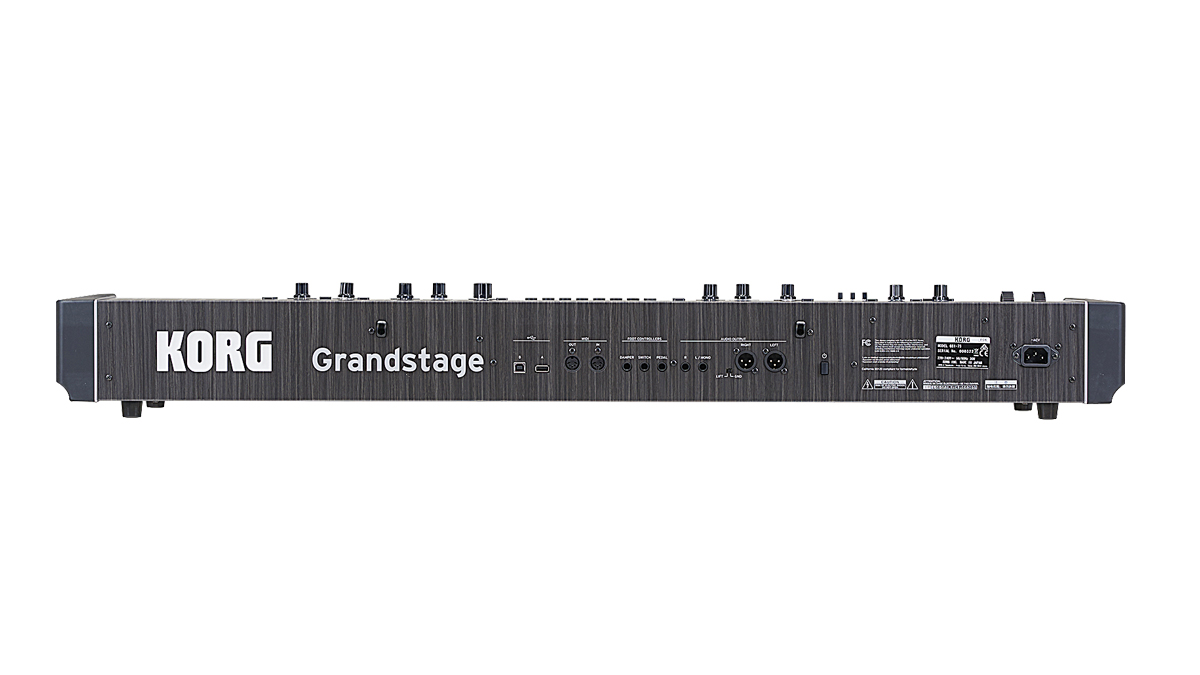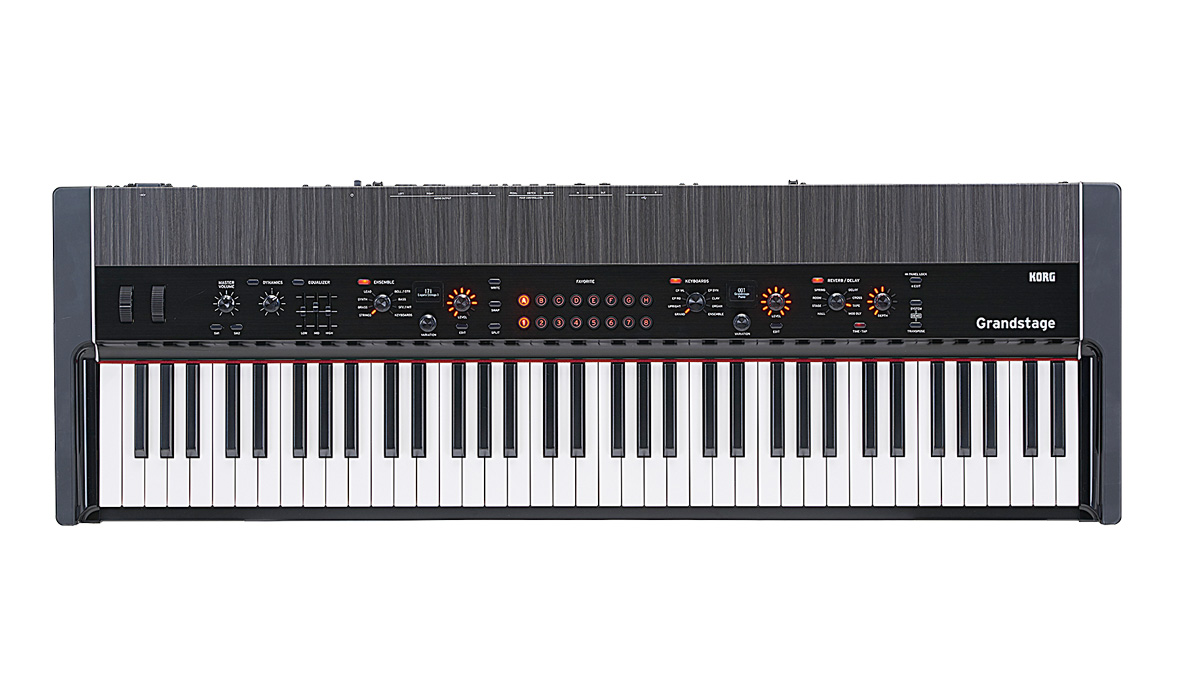MusicRadar Verdict
The Grandstage certainly impresses from start to finish. If you’re after a superb-sounding/ versatile stage piano, then the Grandstage is a class act!
Pros
- +
A classy sounding (and looking) stage piano offering a range of superb Kronos sounds, with intuitive operation and solid build.
- +
A very impressive instrument.
Cons
- -
Cost doesn’t include a case.
MusicRadar's got your back
Korg’s Grandstage is its latest stage piano, sitting alongside the well-respected SV-1 and recently launched Vox Continental.
The Grandstage features seven of the latest Kronos sound engines, including the SGX-2 piano engine, EP-1 electric piano engine, AL-1 analogue modelling engine, HD-1 PCM synth engine, plus CX-3, Vox and Compact (Farfisa) engines - plenty to cover a wide range of bread and butter sounds and more on top of that!
Firstly, let’s look at the form-factor. The Japanese-built Grandstage comes in two versions (73- and 88-note weighted versions), and it looks very sleek with its brushed black metal control panel, boutique grey woodgrain top/rear panel, and black sculpted plastic side panels with silver trim.
The main control panel features red backlit switches and several segmented LED dials for checking levels at a glance on stage, plus there’s also a huge multi-colour (and velocity triggerable!) backlit Korg logo on the rear. Build quality is excellent throughout, though black ash endcheeks would have really completed the premium feel.
Korg’s tried and tested graduated RH3 weighted keybed is featured on both models. The action feels generally well-balanced for piano playing and works OK for the onboard synth, clav and organ sounds too - though bear in mind playing synth sounds from a weighted keybed is always going to be a compromise, no matter how great the weight action!

One thing that would have been great here is a high trigger point (like the Nord Stage models) so that the synth and clav sounds trigger with a more synth-like action. This would have made it feel lighter and faster for playing those patches.
Notably, the Grandstage is bi-timbral, so each of the two main sound sections (Ensemble and Keyboards) can be addressed on its own MIDI Channel - great if you want to address synth sounds from a separate lightweight controller keyboard. Consequently, the two sound sections can be layered or split easily, and a nice touch is the ability to swap the sounds on the left and right of the split with one button.
Now the sound shaping controls: first off, we have pitch and mod wheels. The mod wheel function can be addressed via a connected pedal, whilst it also acts as a volume swell (when using organ sounds) and as a trem/pan speed control on the electric pianos; the pitch wheel also becomes the rotary speed controller for organ sounds.
Underneath the wheels are Korg’s familiar SW1/2 switches, which add extra control over your sounds, such as percussion for organs and chorus or autopan for electric pianos.
Next comes a Dynamics dial (as on the new Vox Continental), controlling how the sound engines respond to your playing style. This is followed by a three-band EQ - although there’s no global ADSR controls onboard, you can tweak release time in the menus. It would be great if a full ADSR menu could be added in an update.
Moving onto the Ensemble section, like the Keyboards section it has its own classy white-on-black OLED screen for displaying program number, name and edit parameters. You simply choose your category using the dial (lead, bass, synth, strings etc) and then select from the considerable number of variations. You can also go in deeper by pressing the Edit button (per-section) and then tweak parameters specific to that category.
Stage pianos need a decent amount of connectivity, and the Grandstage has plenty! There’s a handy front-mounted headphone socket, and at the rear there’s damper, switch and expression pedal inputs (assignable to volume, wah etc) along with MIDI in/out (DIN), plus USB MIDI and USB for data storage. Audio output-wise, there’s standard L and R jack outputs, plus a separate set of balanced XLR outputs too. Also, there’s a bespoke chrome stand, damper pedal and music rest included. Finally, though they’re not accessible directly from the front panel, there’s authentic chorus, phaser, amp-drive, compressor and rotary effects onboard in the menus, plus four types of reverb and four types of delay.
Whilst editing isn’t massively deep, there’s enough onboard to personalise your sounds nicely. Notably, each section’s final category also contains all the sounds from the other main section, so you can have piano, clav or organ running from the Ensemble section and synths, strings or leads from the Keyboards section.
It’s surprisingly flexible and very intuitive and quick to work with, which is especially handy on stage. To the right of each section’s screen is a level control (which can be tweaked on-the-fly), and in the middle of the panel are eight banks of eight favourites, containing some great preset starting points that can be overwritten.
Importantly, the Grandstage also features seamless transitions, so sounds don’t cut off when moving between them.
Sound-wise, the Grandstage is very impressive and versatile and (unsurprisingly) sounds every bit as great as the Kronos. The synth sounds are warm and present, pianos lush and realistic, electric pianos authentic and characterful, the FX musical and complimentary, and the range of sounds on offer will cover just about everything you could want in a stage piano/synth.
“Excels at unique modulated timbres, atonal drones and microtonal sequences that reinvent themselves each time you dare to touch the synth”: Soma Laboratories Lyra-4 review
“I used everything I knew about music”: How Green Day exceeded expectations with their most ambitious song
YouTube just added AI tools that makes musicians, library music and video editors redundant










